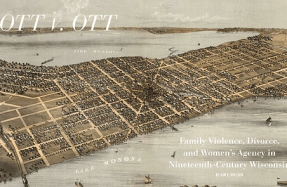THE TRUTH BEHIND “TAIL GUNNER” JOE MCCARTHY

TAIL GUNNER JOE.
It was the perfect nom de guerre for this pugilistic Marine, Joseph Raymond McCarthy, as he launched his first run for statewide office in 1944—casting himself as a World War II warrior fending off Japanese Zeroes as his crew navigated the perilous skies near their Pacific Islands, and a GI Joe keeping safe pint-sized Jacks and Jills back in the Badger State. This battle-tested veteran knew not just how to command attention with his very name, but how to offer up the kind of unflinching, stabilizing leadership that postwar Wisconsin craved.
And it worked, at first. The campaign literature for Joe’s Senate run touted his handle and his heroism, and so did the newspapers. “Appleton Captain Has Triple Exploit While Off Duty,” screamed a headline in the Racine Journal Times.
Chauffeured by three different pilots, the former Wisconsin circuit judge shed his judicial restraint to strafe Jap ground positions with 4,700 rounds of ammunition after the planes he rode in had dive bombed an enemy anti-aircraft emplacement, plastered a Jap bivouac area, and knocked out a field gun shelling American troops on Bougainville. Although normal flight schedules send dive-bomber pilots and gunners into combat only two or three times a week, Captain McCarthy showed no ill effects from his three-in-one exploit.
No wonder voters swooned.
Over time, however, the accolades turned to acid. The Capital Times, a southern Wisconsin competitor of the Journal Times, indicted McCarthy for “phony war heroism.” He was a desk jockey, not an airman, his press critics insisted. When he did tag along with a bomber squadron, the shooting he did was primarily with a camera taking surveillance pictures, the only bullets he fired were at coconut trees, and the sole enemies he dodged were fellow soldiers incensed that he was puffing up his record. His medals attesting otherwise had been awarded as the result of political pressure. Any feats of glory were a candidate’s fantasy. Marine files, reported America’s most widely read columnist, Drew Pearson, “fail to show any record of combat missions.” So widely accepted was this topsy-turvy version of his military record that NBC would mockingly title its made-for-TV movie on McCarthy Tail Gunner Joe, informing anyone who didn’t already know that Joe was a fraud as a war hero and so much else in his life as America’s most notorious Red-hunter.1

Seventy-five years later, it turns out that McCarthy—pegged by history as a chronic liar—was actually telling the truth about this formative chapter of his biography. His political enemies fabricated their own rendering of his war record in order to bring him down, just as he said they did.
We know this from his personal diaries, compiled while he was in the service and buried in the senator’s personal and professional papers at his alma mater, Marquette University, which were under] woman during menopause”), suggests the diary is an authentic, unfiltered day-by-day chronicle never meant to be shared. It also demonstrates that his hyperbole came naturally, long before he became a politician.
You’re reading a preview, subscribe to read more.
Start your free 30 days





